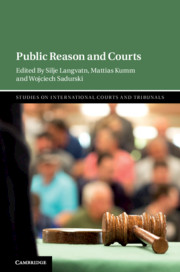Book contents
- Public Reason and Courts
- Studies on International Courts and Tribunals
- Public Reason and Courts
- Copyright page
- Contents
- Contributors
- Preface
- Acknowledgments
- 1 Taking Public Reason to Court: Understanding References to Public Reason in Discussions about Courts and Adjudication
- Part I Public Reason in Constitutional Courts
- 2 Must Laws Be Motivated by Public Reason?
- 3 The Importance of Constitutional Public Reason
- 4 The Question of Constitutional Fidelity: Rawls on the Reason of Constitutional Courts
- 5 The Challenges of Islamic Law Adjudication in Public Reason
- 6 “We Hold These Truths to Be Self-Evident”: Constitutionalism, Public Reason, and Legitimate Authority
- 7 A Kantian System of Constitutional Justice: Rights, Trusteeship, Balancing
- 8 Laws, Norms, and Public Justification: The Limits of Law as an Instrument of Reform
- Part II Public Reason in International Courts and Tribunals
- Part III Critical Perspective on Public Reason in Courts
- Index
7 - A Kantian System of Constitutional Justice: Rights, Trusteeship, Balancing
from Part I - Public Reason in Constitutional Courts
Published online by Cambridge University Press: 22 May 2020
- Public Reason and Courts
- Studies on International Courts and Tribunals
- Public Reason and Courts
- Copyright page
- Contents
- Contributors
- Preface
- Acknowledgments
- 1 Taking Public Reason to Court: Understanding References to Public Reason in Discussions about Courts and Adjudication
- Part I Public Reason in Constitutional Courts
- 2 Must Laws Be Motivated by Public Reason?
- 3 The Importance of Constitutional Public Reason
- 4 The Question of Constitutional Fidelity: Rawls on the Reason of Constitutional Courts
- 5 The Challenges of Islamic Law Adjudication in Public Reason
- 6 “We Hold These Truths to Be Self-Evident”: Constitutionalism, Public Reason, and Legitimate Authority
- 7 A Kantian System of Constitutional Justice: Rights, Trusteeship, Balancing
- 8 Laws, Norms, and Public Justification: The Limits of Law as an Instrument of Reform
- Part II Public Reason in International Courts and Tribunals
- Part III Critical Perspective on Public Reason in Courts
- Index
Summary
The chapter develops a Kantian account of constitutional justice: the explication of those structural features of a legal system whose purpose is to optimize a polity’s capacity to achieve a Rightful condition. The People, in enacting a rights-based constitution, have placed their freedom in trust. Rights ground a system of reciprocal freedom among individuals, while conferring on officials the authority to make and enforce law, subject to constraints laid down by the Universal Principle of Right (UPR). A constitutional court, the trustee of the regime, supervises the rights-regarding acts of all other officials, assesses the reasons officials give when they make decisions that burden rights, and invalidates those acts when reasons given to justify such burdens fail to meet the demands of the UPR. Although some rights will be expressed in absolute terms, most will be qualified by a limitation clause. In adjudicating qualified rights, the court can do no better than to adopt the proportionality principle. The UPR, operationalized through proportionality analysis, lays down a basic criterion for the legitimacy of all law.
Keywords
- Type
- Chapter
- Information
- Public Reason and Courts , pp. 164 - 200Publisher: Cambridge University PressPrint publication year: 2020



